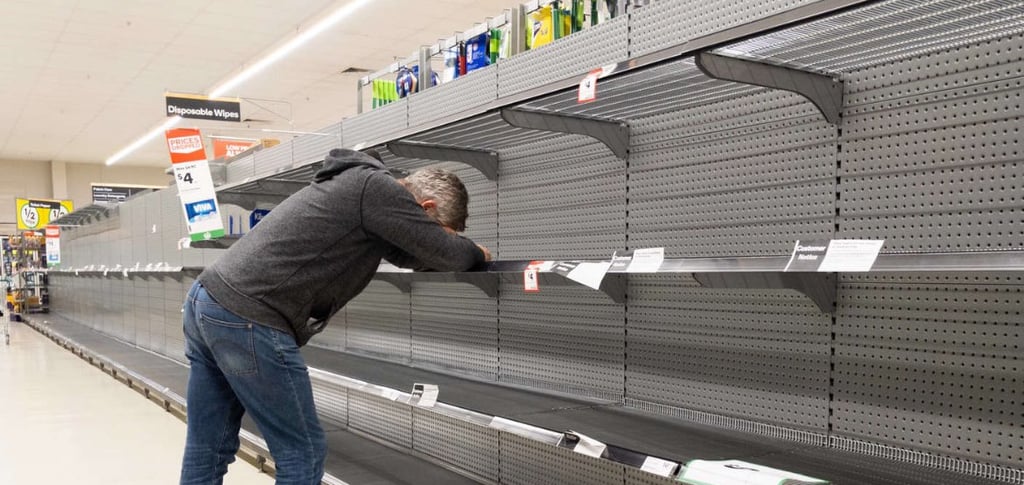The Empty Shelves Crisis: How Trump’s Tariffs Are Reshaping America’s Economy
4/26/20254 min read


The Empty Shelves Crisis: How Trump’s Tariffs Are Reshaping America’s Economy
A Startling Visual of Our Supply Chain Woes
Picture this: a man in a store, head resting on an empty shelf, surrounded by barren racks. This isn’t a scene from a dystopian movie—it’s a real image shared by Charly Bühler on X, capturing the stark reality of America’s supply chain crisis in April 2025. The post, replying to Spencer Hakimian’s alarming data, shows import volumes at the Port of Los Angeles plummeting from 120,589 TEUs (Twenty-Foot Equivalent Units) in late April to just 72,941 by early May—a staggering 40% drop in two weeks. What’s behind this collapse? Trump’s tariffs, which Bühler hashtags as the market-crashing culprit. Let’s unpack this unfolding economic drama.
The Numbers Don’t Lie: Imports Are Crashing
Hakimian’s data, posted on April 25, 2025, reveals a grim trend at the nation’s largest port. From April 20-27, import volumes stood at 120,589 TEUs, but by May 4-10, they’d nosedived to 72,941. That’s a 34.4% drop year-over-year, with scheduled vessels dwindling from 22 to 16. Hakimian’s take? “We are already in a recession.” He warns that the best-case scenario is to “stop the bleeding right here,” but the options look bleak. The ripple effects are clear: fewer goods arriving means fewer products on shelves, as Bühler’s image vividly shows.
Trump’s Tariffs: A Game-Changer or a Market Crasher?
Bühler points the finger at Trump’s tariffs, specifically targeting imports from China. According to a CNBC report from April 17, 2025, these tariffs—escalating to 145% on Chinese goods—aren’t bringing manufacturing back to the U.S. as promised. Instead, companies are globe-hopping to low-tariff regions, with costs of reshoring doubling for many. Paul Brashier from ITS Logistics noted a “heavy cancellation or pause rate” for freight from China, while imports from other Asian countries temporarily surged due to tariff exemptions. But those exemptions are short-lived, and the damage is mounting.
Empty Shelves, Empty Promises
The image Bühler shared—a man in a hoodie slumped over an empty shelf—speaks volumes. This isn’t just about fewer luxury goods or discretionary items (which a CNBC survey pegged as 44% of the hardest-hit categories). It’s about raw materials and parts critical for production, much of which comes from China. In 2024, China accounted for 37% of U.S. apparel imports and 58% of footwear, per the American Apparel and Footwear Association. With tariffs acting as a de facto “import ban,” as Steve Lamar of the AAFA put it, retailers like Walmart, IKEA, and Target are seeing order pullbacks, according to SONAR data. The result? Shelves are going bare, and consumers are feeling the pinch.
The Economic Fallout: Inflation, Uncertainty, and More
The tariff fallout isn’t just about empty shelves—it’s fueling economic uncertainty. A Deloitte report from April 11, 2025, highlighted how tariffs are driving inflation expectations, with the University of Michigan’s one-year-ahead inflation figure hitting a 28-month high of 4.9% in March. The Federal Open Market Committee also raised its core inflation projection to 2.8% for 2025. Meanwhile, the Institute of Supply Management reported a decline in manufacturing orders in February—the first in four months—while small business optimism tanked, per the National Federation of Independent Business. The lack of clarity on tariff structures is paralyzing businesses, making it hard to plan investments or adjust supply chains.
Consumers Bear the Brunt
For everyday Americans, the effects are tangible. Jonathan Gold of the National Retail Federation warned of “less inventory, fewer choices, and increased prices,” especially for small retailers. While some companies frontloaded inventory in early 2025 to dodge tariffs, that stockpile is running dry. As shipments with higher tariffs arrive, retail shortages will deepen. Apparel and footwear, heavily reliant on Chinese imports, are particularly vulnerable. The AAFA noted that tariffs on these goods now exceed 160% in some cases, making it nearly impossible for companies to absorb costs without passing them onto consumers—or canceling orders altogether.
A Recession in the Making?
Hakimian’s assertion that “we are already in a recession” isn’t far-fetched. The Conference Board’s March 2025 data showed weakened consumer expectations, and the sharp drop in port activity signals a broader economic slowdown. Bühler’s hashtag #TrumpTariffs => Crash the market echoes a growing fear: these policies might push the economy over the edge. While the Trump administration touts a reshoring boom—think Nvidia’s supercomputer plant or Apple’s $500 billion U.S. investment—most companies find the costs prohibitive. The White House’s ongoing national security probes into critical tech could lead to even more tariffs, further straining global trade.
What’s Next for America’s Supply Chains?
The path forward is murky. A Chinese minister recently confirmed there are “absolutely no negotiations” on trade between the U.S. and China, dimming hopes for a quick resolution. As tariffs persist, companies will keep searching for low-tariff havens, but that’s a band-aid, not a solution. For now, consumers face a new reality: higher prices, fewer options, and a supply chain stretched to its breaking point. The empty shelves in Bühler’s photo might just be the beginning.
Thought Questions to Ponder
How will rising prices and shortages affect your shopping habits in the coming months?
Do you think Trump’s tariffs will eventually bring manufacturing back to the U.S., or are they doing more harm than good?
What steps can businesses and consumers take to adapt to this new economic landscape?
Photo Credit: GettyImage
hello@boncopia.com
+13286036419
© 2025. All rights reserved.